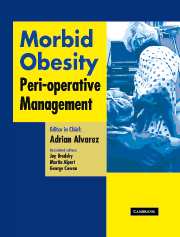Book contents
- Frontmatter
- Contents
- Contributors
- Foreword
- Preface
- Acknowledgments
- Dedication
- Section 1 General aspects
- Section 2 Pathophysiology
- Section 3 Pre-operative management
- Section 4 Peri-operative management of co-morbidities
- 10 Diabetes mellitus
- 11 Co-existing cardiac disease
- 12 Deep venous thrombosis prophylaxis
- 13 Surgical antibiotic prophylaxis
- 14 Renal dysfunction
- Section 5 Pharmacology
- Section 6 Monitoring
- Section 7 Intra-operative management
- Section 8 Post-operative care
- Section 9 Conclusions
- Afterword
- Index
11 - Co-existing cardiac disease
from Section 4 - Peri-operative management of co-morbidities
Published online by Cambridge University Press: 17 August 2009
- Frontmatter
- Contents
- Contributors
- Foreword
- Preface
- Acknowledgments
- Dedication
- Section 1 General aspects
- Section 2 Pathophysiology
- Section 3 Pre-operative management
- Section 4 Peri-operative management of co-morbidities
- 10 Diabetes mellitus
- 11 Co-existing cardiac disease
- 12 Deep venous thrombosis prophylaxis
- 13 Surgical antibiotic prophylaxis
- 14 Renal dysfunction
- Section 5 Pharmacology
- Section 6 Monitoring
- Section 7 Intra-operative management
- Section 8 Post-operative care
- Section 9 Conclusions
- Afterword
- Index
Summary
Introduction
Over 150 years ago William Wadd stated “corpulency is not only a disease itself but the harbinger of others”. Obesity has been shown to induce multiple risk factors and cluster risk factors which can lead to a variety of co-morbidities including cardiovascular diseases. Obesity is a global problem with the prevalence of obesity continuing to increase. In the US, the age adjusted prevalence of overweight individuals with body mass index (BMI ≥ 25), increased from 55.9% (1988–1994) to 64.5% (1999–2000). Similarly, the prevalence of obesity (BMI ≥ 30), increased from 22.9% to 30.5%, while extreme obesity (BMI ≥ 40) nearly doubled from 2.9% to 4.7%.2 Cardiovascular diseases are common in obese individuals and manifest as ischemic heart disease (IHD), hypertension, and cardiac failure. The incidence of cardiovascular disease is reported in 37% of the adults with BMI > 30 kg/m2, 21% with a BMI of 25–30 kg/m2 and only 10% in those with BMI < 25 kg/m2. Costs related to cardiovascular disease related to overweight and obesity in the US was estimated to be $31.0 billion in 1996.
The relationship between the increase in blood pressure (BP) and the risk of cardiovascular disease is continuous, consistent, and independent of other risk factors. The chances of myocardial infarction (MI), heart failure, stroke, and kidney disease are all greater with increasing BP.
- Type
- Chapter
- Information
- Morbid ObesityPeri-Operative Management, pp. 141 - 166Publisher: Cambridge University PressPrint publication year: 2004



